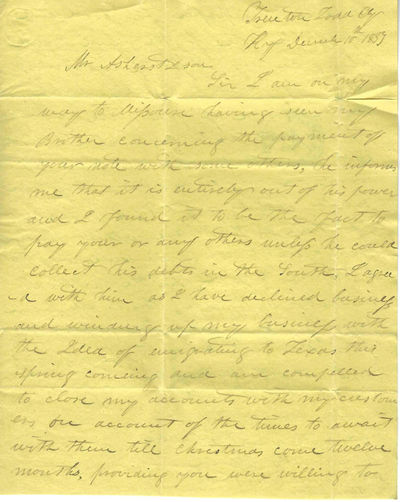Autograph Letter Signed, Trenton, Todd County, Kentucky, Dec. 10, 1837, to Richard Asherst & Son, Philadelphia
- SIGNED
Quarto, two pages, plus stampless address leaf, in very good, clean and legible condition.
1837 Future St. Louis millionaire, as Missouri Pioneer, dreams of Texas – but went on to make a Fortune in Gold Rush California and Montana.
"Sir I am on my way to Missouri, having seen my Brother concerning the payment of your note … he informs me that it is entirely out of his power … to pay your or any others unless he could collect his debts in the South, I agreed with him as I have declined business with the idea of emigrating to Texas this spring coming and am compelled to close my accounts with my customers on account of the times to await with them till Christmas come twelve months, providing you were willing to exchange his paper for good and responsible notes of the kind I am taking on my Missouri customers dollar for dollar I will make the exchange if you will authorize your agent in time … Sir the matter is entirely with you, this is all I can possibly do … write me at Columbia Boon County Missouri…"
Born in Tennessee, Dorriss worked in his father's mercantile business until the lure of mining took him to Illinois, where he started his own business in Shawneetown (later Todd County, Kentucky) and served as n Army General in the Black Hawk War, thus outranking Illinois Captain Abraham Lincoln. In 1836, the US Government purchased 3000 square miles of land from Indians in territory northwest of the state of Missouri who agreed to be relocated to reservations west of the Missouri River. Nine months before the 30-year-old Dorriss wrote this letter, President Van Buren proclaimed that land part of Missouri state and opened it for settlement. Dorriss quickly bought up a valuable tract of land in the new frontier territory, where, rather than moving to Texas, he remained with his family, buying up land throughout the states – thousands of acres, including a slave plantation – and being elected to the state Legislature. A decade later, when gold was discovered in California, the already wealthy Dorriss, became a Forty-Niner. He outfitted 40 wagons with goods and trekked overland to Sacramento, where he became one of the first Gold Rush merchants with goods to sell. When the gold petered out, he returned to Missouri, moving to St. Louis. During the Civil War, he supplied mining equipment to the new gold-seekers of Montana. By the time he died in 1882, Dorriss owned real estate throughout St. Louis, including 50 landscaped acres on which he built an imposing mansion. He left a fortune that enabled one of his descendants, at the turn of the century, to establish the St. Louis Motor Car Company which played an important part in the fledgling American automobile industry.
1837 Future St. Louis millionaire, as Missouri Pioneer, dreams of Texas – but went on to make a Fortune in Gold Rush California and Montana.
"Sir I am on my way to Missouri, having seen my Brother concerning the payment of your note … he informs me that it is entirely out of his power … to pay your or any others unless he could collect his debts in the South, I agreed with him as I have declined business with the idea of emigrating to Texas this spring coming and am compelled to close my accounts with my customers on account of the times to await with them till Christmas come twelve months, providing you were willing to exchange his paper for good and responsible notes of the kind I am taking on my Missouri customers dollar for dollar I will make the exchange if you will authorize your agent in time … Sir the matter is entirely with you, this is all I can possibly do … write me at Columbia Boon County Missouri…"
Born in Tennessee, Dorriss worked in his father's mercantile business until the lure of mining took him to Illinois, where he started his own business in Shawneetown (later Todd County, Kentucky) and served as n Army General in the Black Hawk War, thus outranking Illinois Captain Abraham Lincoln. In 1836, the US Government purchased 3000 square miles of land from Indians in territory northwest of the state of Missouri who agreed to be relocated to reservations west of the Missouri River. Nine months before the 30-year-old Dorriss wrote this letter, President Van Buren proclaimed that land part of Missouri state and opened it for settlement. Dorriss quickly bought up a valuable tract of land in the new frontier territory, where, rather than moving to Texas, he remained with his family, buying up land throughout the states – thousands of acres, including a slave plantation – and being elected to the state Legislature. A decade later, when gold was discovered in California, the already wealthy Dorriss, became a Forty-Niner. He outfitted 40 wagons with goods and trekked overland to Sacramento, where he became one of the first Gold Rush merchants with goods to sell. When the gold petered out, he returned to Missouri, moving to St. Louis. During the Civil War, he supplied mining equipment to the new gold-seekers of Montana. By the time he died in 1882, Dorriss owned real estate throughout St. Louis, including 50 landscaped acres on which he built an imposing mansion. He left a fortune that enabled one of his descendants, at the turn of the century, to establish the St. Louis Motor Car Company which played an important part in the fledgling American automobile industry.


